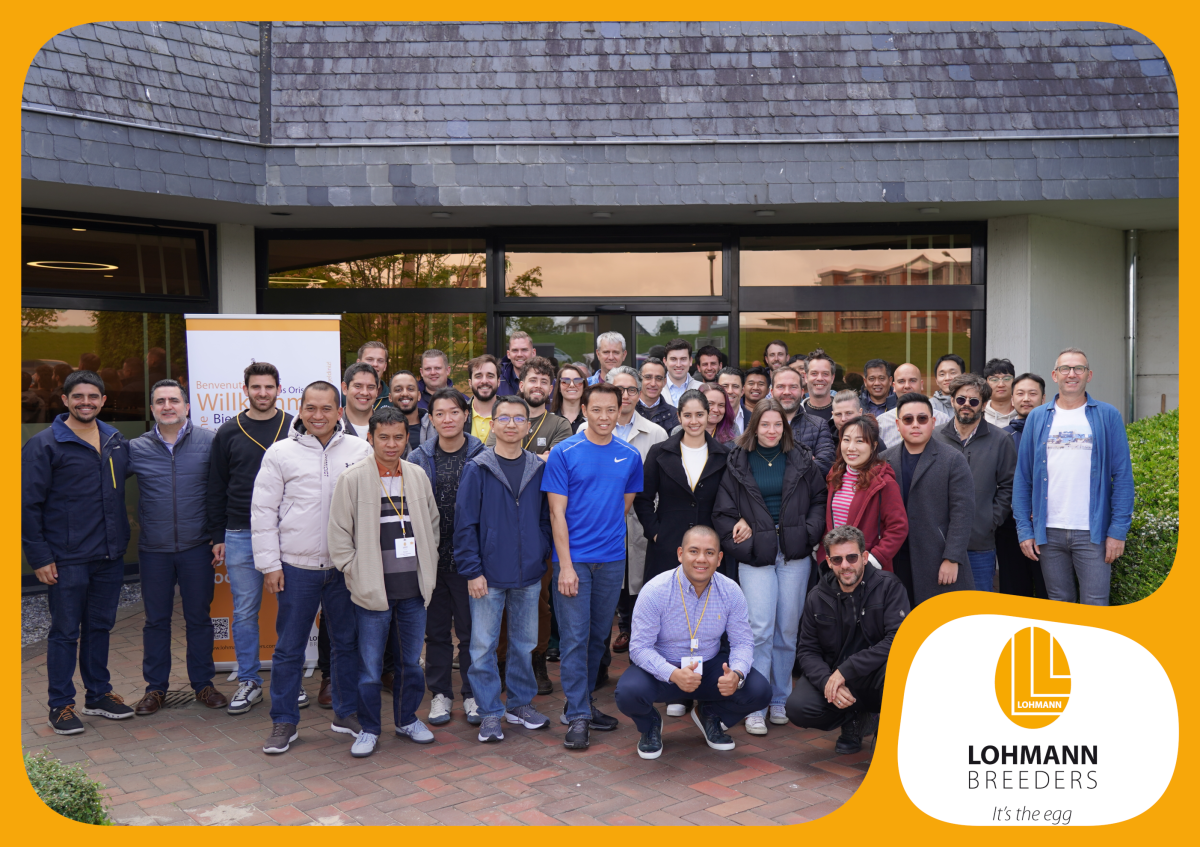Summary
In this paper, we provided an analysis of irrigation water management in the province Khorezm of
Uzbekistan and presented recommendations on how water management can be improved.
The analysis takes into account the local context of water management and derives its results from
an interdisciplinary analysis of socio-economic, technical, and bio-physical aspects. We have described
three different types of practices, which actors involved in water management apply: formal practices,
strategic practices, and discursive practices. We also outlined the infrastructural deficiencies in irrigation
and drainage network and their implications for unreliable and inadequate water delivery. We have
concluded that the three types of practices and the poor status of water conveyance and monitoring
systems shape water management in Khorezm. In our recommendations to improve the irrigation
management, we have analysed water management at different levels from the state water management
level to the farmer and field level. We concluded that transparency, accountability, and participation
matter and need to be improved to create an enabling environment for improving the efficiency of the
irrigation system. Furthermore, the irrigation infrastructure and technical efficiency should be improved.
There is a huge water saving potential in the region without adversely affecting the agricultural
productivity. Our key message is that the technical and institutional improvement options have to go
hand in hand as they rely on each other to achieve an efficient, equitable, and sustainable irrigation
Introduction
Khorezm, one of the twelve provinces of Uzbekistan, is one of the oases of the great historic civilizations of Central Asia, fed by the ancient river Oxus, today the Amu Darya. For at least 3000 years, waters from the Amu Darya and Syr Darya rivers supported thriving agricultural communities in the Aral Sea Basin (ASB) (Figure 1). But during the Soviet era (1924-1991), and particularly since the late 1950ies, the Amu Darya and Syr Darya rivers were tapped excessively and used in immense irrigation systems to secure the production of cotton, the “White Gold”. The area of irrigated land in the ASB almost doubled, from 4.5 million ha in the fifties to 7.9 million ha in 2006. This dramatic expansion of the irrigation system resulted in substantial decrease in water inflow to the Aral Sea from 43 km³ year-1 in 1960s to only 9 km³ year-1 during 2001-2005. Consequently, within decades the Aral Sea shrunk from being the fourth largest freshwater lake in the world (6.8 million ha surface area) to less than 20% of its former surface. By 2006 the sea’s level had dropped 23 m, the volume decreased by 90%, and the salinity rose to more than 100 g l-1 (Micklin 2007). The desiccation of major parts of the Sea continues to threaten ecosystems and livelihoods, particularly in the circum-Aral region.Figure 1 Map of the Aral Sea Basin (ASB) with the location of Khorezm province in Uzbekistan.
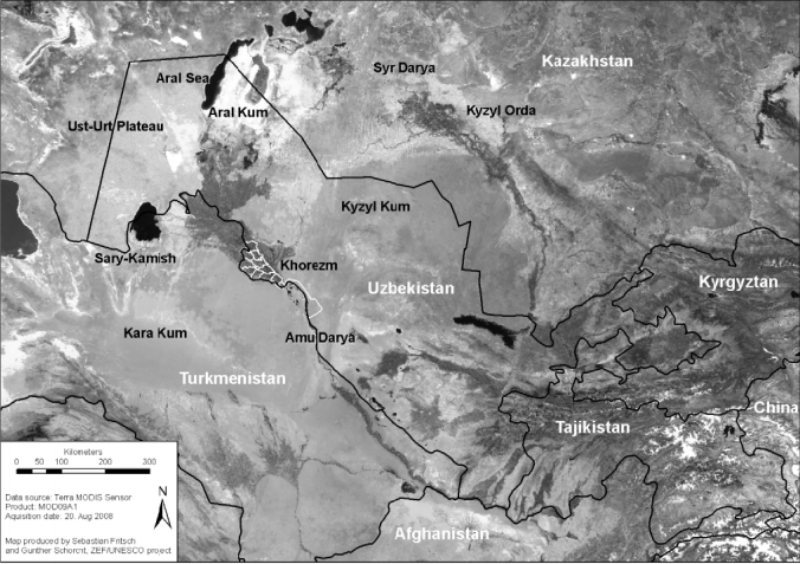
It is extremely doubtful that the Aral Sea could be restored to its pre-1960s level, size, and ecological state, as this would necessitate a 51% reduction in annual irrigation withdrawals of 105 km³. Given the dependency of the two primary irrigation water users in the basin (Uzbekistan and Turkmenistan) on cotton production as a major source of foreign currency revenues, significant reductions in irrigated area and water use are highly unlikely in the near to mid-term future. Providing solutions to the adverse environmental, economic, and social impacts of the Aral Sea disaster is of crucial importance for the sustainable development of the basin. However, “creeping environmental problems” such as the Aral Sea desiccation require “creeping solutions” (Glantz, 2008) i.e. incremental steps that can be taken to improve the resource-use efficiency and environmental as well as socio-economic conditions.
In this context, the BMBF1 funded ZEF/UNESCO project “Economic and Ecological Restructuring of land and Water Use in the Region Khorezm, Uzbekistan (www.uni-bonn.de/khorezm)”, was initiated to develop comprehensive, science-based concepts and technologies for improving economic efficiency and ecological sustainability of agricultural land and water use in the Khorezm region.
In this paper, we analyse the socio-technical aspects of the irrigation water management system in Khorezm and discuss options for improving the efficiency, equity, and sustainability of water use in the region. This article is partly based on Oberkircher, L., Tischbein B., Hornidge, A.-K., Schorcht, G., Bhaduri, A., Awan, U.K., Manschadi, A.M., forthcoming: Reconceptualising Water Management in Khorezm, Uzbekistan / Recommendations towards IWRM, ZEF Working Paper Series. Vol. 54. Bonn: Zentrum für Entwicklungsforschung.
Key characteristics of the Khorezm region
Khorezm is located in the northwest of Uzbekistan about 250 km south of the present shores of the Aral Sea (Figure 1). It covers an area of about 6,800 km² of mostly dry arid desert of which roughly 270,000 ha can be used for irrigated agriculture. The region is characterised by a continental arid climate with hot and dry summers and cold winters with an annual average precipitation of less than 100 mm. Hence, agricultural production and rural livelihoods in Khorezm rely entirely on irrigation water supply from the Amu Darya river.
Of the 1.5 million of Khorezm’s population (as of 2008), over 70% resides in rural areas and is mostly engaged in cotton, wheat and rice production either as private farmers (fermers), peasants (dehqons), workers on private farms, or a combination of the latter two. Unemployment rates are high and about 28% of the population live below the poverty line of 1 US$ per day (Müller 2006).
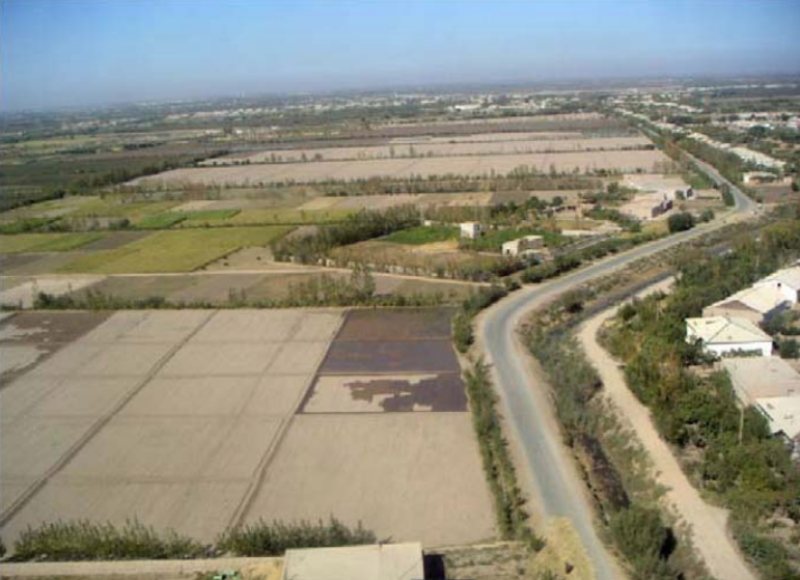 Irrigated crop fields in the Khorezm province, Uzbekistan (photo courtesy of Dr. G. Rücker)
Irrigated crop fields in the Khorezm province, Uzbekistan (photo courtesy of Dr. G. Rücker)German Federal Ministry of Education and Research
Agricultural production system
Agriculture is the most important sector of the economy in Khorezm accounting for about 67% of the total regional GDP. At present, cotton, wheat, rice and fodder maize dominate the crop portfolio of the farmers in the region. Other crops such as potatoes, vegetables, fruits, grapes and melons are produced mainly on rural household plots for home consumption or sale on local markets (Bobojonov 2008).
Cotton plays by far the largest role in the regional economy – it occupies 50% of the irrigated cropland, consumes about 40% of the total water supply to the region, contributes as much as 16% to the GDP, and earns virtually 99% of the total export revenues of Khorezm (Rudenko 2008).
Cultivation of winter wheat was introduced in 1992 as part of the national programme for achieving food self-sufficiency. Consequently, the area under wheat in Khorezm increased to about 20% particularly at the expense of fodder crops such as lucerne (Djanibekow 2008), which was widely cultivated in rotation with cotton during the Soviet Union period. Rice is the third important crop in Khorezm and almost one-third of rice in Uzbekistan is produced in this region. In spite of occupying only 10% of the cropped area, rice consumes around 30% of the total water supply because it is grown in paddies; small basins which are flooded with water throughout most of the growing season from April-May until September.
One of the key characteristics of agriculture in Khorezm is that cotton and winter wheat are produced under the so-called ‘state-order’ or ‘state-procurement’ system (Djanibekow 2008). This means at the onset of each cropping season, the state government imposes production ‘quotas’ and determines the area on each farm that has to be allocated to cotton and winter wheat. The government also sets the prices, and organizes the processing and export (in the case of cotton). In turn, it ensures the supply and delivery of water, diesel, fertilisers, and other required inputs via state-controlled agencies (Rudenko 2008). The input prices are entirely determined by the central government and there is no private input market. The amount of cotton and winter wheat that farmers must deliver is determined by the soil fertility of their fields, expressed as soil bonitet. The local government officials use the soil bonitet index to determine the crop yields that the farmers must obtain from each individual field.
Based on this system of area- and production-based quota for cotton and wheat, the irrigation management organisations at national, regional, and local level determine crop water requirements and develop delivery plans for each cropping season (see below).
The prescription of the strategic crops cotton and winter wheat by the national administration is exclusively restricted to the fermers (private farmers). These family-based agricultural enterprises have evolved following a series of land reforms initiated by the Government of Uzbekistan to decollectivise the former state and collective farms. The fermers have lease contracts of up to 50 years because agricultural land has remained state property. In 2007, there were 17000 fermers in the Khorezm region with an average farm size of about 10-40 ha (Djanibekow 2008). Despite the ongoing lease contracts, farmland was recollected by the state at the end of 2008 and once more redistributed in bigger plots to roughly one fourth of the former fermers (Djanibekow et al. 2010). In the course of land reforms, subsistence farmers (dehqons) were also granted a private plot of about 0.13 irrigated hectares (called tamorka). This was in addition to the garden plot of 0.12 ha (around the house).
These tamorka plots account for about 20% of the irrigated land in Khorezm and play an important role in the production of fodder, vegetables, and fruits.
Irrigation water management
Officially, about 3.5 – 5 km³ of water per year are diverted from the Amu Darya river to irrigated fields in Khorezm through a dense network of 16000 km irrigation channels. During the severe droughts such as in 2000, 2001, and 2008, however, water supply to the region can be reduced by 40%. The water arriving in Khorezm is partly stored in the Tuyamuyun water reservoir, and its volume is rationed depending on the monthly water demand in the region. More than 95% of the water is used for agricultural purposes. Irrigation water is conveyed to the fields in open, predominantly non-lined channels resulting in substantial losses due to percolation, seepage, evaporation, and overflow to the drainage system. In 2005, a year with sufficient water supply, nearly 60% of incoming water ended up in the drainage system flowing directly to desert sinks (Conrad et al. forthcoming).
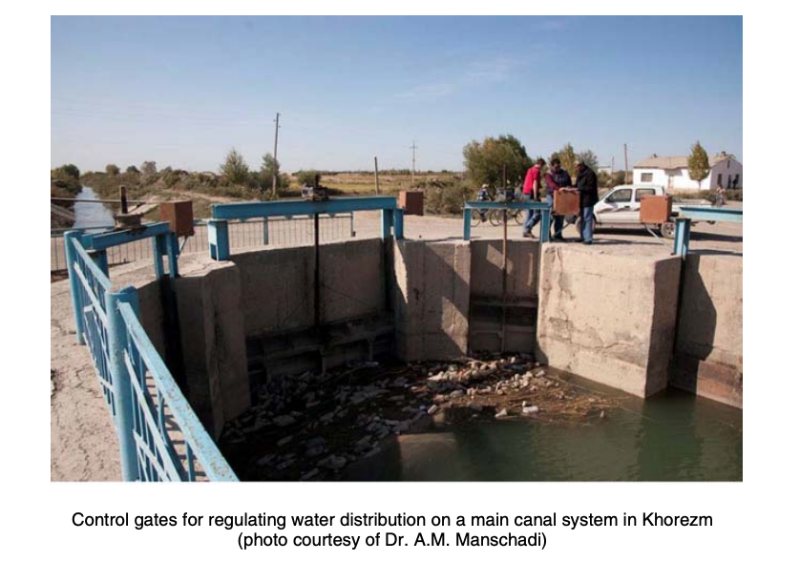
Vulnerability to fluctuations in water supply
Due to its tail-end situation along the Amu Darya river, the Khorezm region highly reliest on the upstream areas for water supply. The Amu Darya’s water is derived from the mountain ranges of the Pamirs and Tien-Shan located in the upstream countries Kyrgyzstan, Tajikistan and Afghanistan. About 85% of the total surface water resources in the ASB (117 km³) is formed in the territories of these countries. The major water users in the basin, however, are the downstream nations Uzbekistan, Turkmenistan, and Kazakhstan, which together account for 82% of water consumption. Uzbekistan alone consumes about 50% of the total river flow in the basin (Figure. 2).
Figure 2 Average annual water flow formation and withdrawals in the Aral Sea Basin (data
source: Micklin 2007)
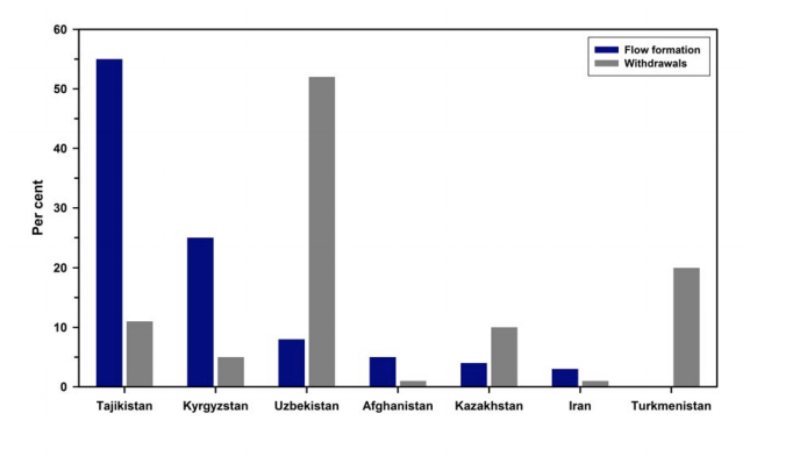
This distinct spatial pattern of water formation–water consumption in the ASB has been the source of tensions over water use among and within the riparian states. Under the Soviet Union, a centrallyplanned system of water quotas regulated water allocation among the five Central Asian republics with the overall aim of providing irrigation water to downstream regions in the summer for maximising the cotton production. In exchange for water, the energy-scarce upstream republics (Kyrgyzstan and Tajikistan) received fossil fuels (coal and gas) at subsidised prices to generate electricity and heat in the winter. The breakdown of Soviet Union and establishment of independent Central Asian republics in 1990 ended this centrally-managed “water-energy nexus”. Higher post-Soviet market prices for oil and gas together with unreliable delivery and the pursuit of energy security in the upstream countries increased the demand for hydropower in upstream republics. As a result, large quantities of water are released by up-stream countries in winter to generate heat and electricity during peak demand season, so that less water is available during the summer irrigation season in downstream regions.
While Central Asian countries have so far managed to avoid open conflicts over water, the situation might spin out of control in the future. Climate change, accelerated melting of glaciers, and changes in temperature and rainfall patterns will undoubtedly increase the occurrence of extreme weather events such as frost, droughts, and floods in the region. In 2008, for instance, a severe drought combined with an extremely cold winter resulted in a compound water-energy-food crisis and serious political tensions in Central Asia. Furthermore, the downstream water availability is likely to worsen if Afghanistan stabilises and begins to develop new irrigation schemes and uses more water (planned are at present about 800000 ha). Therefore it is likely that the downstream regions, such as Khorezm province, will particularly be affected by decreasing water availability.
Water management practices
The Soviet heritage and the extensive irrigation and drainage systems established over decades of central planning created a strong “path dependency” of the agricultural production on central administrative systems. The state quota for cotton and wheat is the major determinant of the irrigation water management process in the Khorezm region. As supply of water is a key factor for the fulfilment of production quotas, a number of state organisations on different administrational levels (Figure 3) are formally responsible for the allocation and delivery of water from the off-takes along the Amu Darya river to the entrance of the Water User Associations (WUAs). Allocation hereby refers to the assignment of so called water limits to different units within the irrigation network. These limits are determined through water requests based on irrigated area, planted crops, and the respective irrigation state norms. These are passed on and aggregated on various organisational levels from the dehqon (peasant) and fermer (private farmer) via the WUA, UIS (sub-basin irrigation system authority), and BUIS (lower Amu Darya basin irrigation system authority) to the national Ministry of Agriculture and Water Resources (MAWR). The allocation of limits is carried out vice-versa from MAWR downwards, and water quantities are allocated among different water management units on each level (Martius et al. 2009). Therefore, the national MAWR is the ultimate authority responsible for the planning and allocation of irrigation water in Uzbekistan. It collaborates on transboundary water management, i.e. allocation of annually agreed water volumes to Uzbekistan, with the Interstate Commission for Water Coordination of Central Asia (ICWC) with Kazakhstan, Kyrgyzstan, Tajikistan, Turkmenistan and Uzbekistan as members and Afghanistan as consulting partner.
The physical delivery of water and the operation and maintenance of the irrigation and drainage network is also the responsibility of state water management organisations, mainly the Main Canal Management (MCM) units of UIS. However, due to inadequate human, financial, and technical resources, they are largely unable to provide the required services. This has resulted in poor functioning of the irrigation and drainage infrastructure and hampered the provision of measurement and communication equipment, which are essential for timely, reliable, and equitable water supply. Similarly, the on-farm irrigation and drainage network has been deteriorating, since the WUAs, which are formally responsible for maintenance and operation of infrastructure within their boundaries, fail to fulfil their obligations. WUAs were introduced between 2000 and 2005 in Khorezm along the administrative boundaries of the former collective farms. Due to the lack of a state budget, WUAs rely on fee collection from water users for covering the operation and maintenance costs of the irrigation system. The water users, however, are reluctant to pay the irrigation service fees because (i) WUAs are organised in a top-down hierarchical manner without active participation of water users, (ii) small farming units (up to 1 ha cropland) are not represented by WUAs, and (iii) poor performance of WUAs with respect to dependability and equity of irrigation water delivery particularly in water-scarce years. Hence, the WUAs have so far failed to become effective organisations for farm-level water supply management.
Figure 3 Water allocation through limits (Veldwisch 2008)
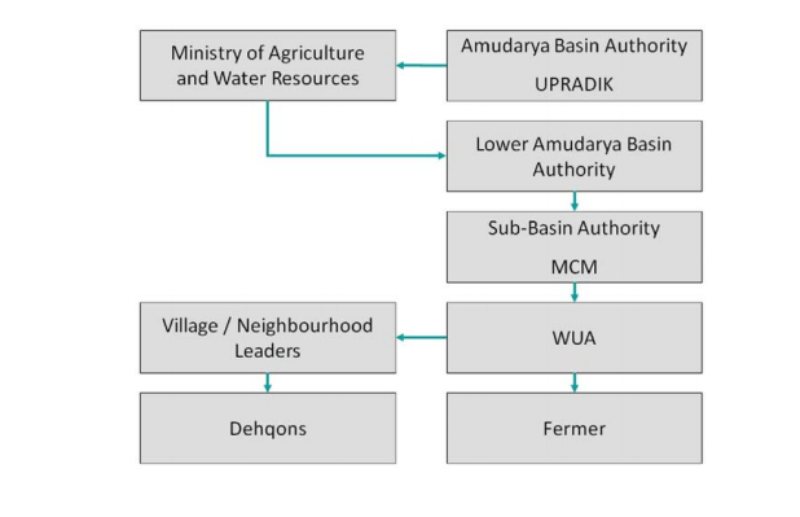
While, formally, water delivery should match the water allocations, the actually delivered water quantities depend on many factors, only one of them being the official limits. In fact water users apply different strategies to access water outside the formal functioning of the water management organisations (Veldwisch 2008). Such strategic practices are a deviation from the formal rules of water management in Khorezm, reveal a strong agency of the actors involved, and follow their own set of informal institutions. One example is the use of small, mobile pumps to lift water into field canals, which is formally considered illegal theft of water, but is informally a wide-spread practice (Oberkircher and Ismailova forthcoming). Also the individual instead of collective actions explain the increasing number of water conflicts between members especially during water scarce years. Thus by catering to individuals’ water demands, water delivery according to strategic practice (both with the help of technical means or social relations) is a deviation from the formal water management institutions but at the same time effectively compensates inadequacies of the formal water management organisations – at least for influential agents (Oberkircher et al 2010).
Despite frequent malfunctioning of the water management system and widespread deviation (strategic practices), the formal institutions appear to be surprisingly resilient. An explanation might be found in the continuous processes of strengthening and reproducing the system through discursive practices of the actors involved (Oberkircher et al. 2010). The deviant actors spend considerable effort and resources on the discursive compensation of their behaviour. When in the case study WUAs fermers deviate from the rule that cotton as a state crop should be irrigated before the cash crop rice, they tended to state in any official conversation that cotton needs to be irrigated first. Whereas individuals take water management actively into their own hands and pursue their own interest, their statements suggest that ‘water management is up to the state’.
Opportunities for improving irrigation system management
Considering the inefficient use of water resources and the likely decrease of water supply in the future, the current irrigation management system in Khorezm can certainly not be considered sustainable. Implementation of an innovative, efficient, and participatory irrigation management system may help in not only saving considerable quantities of water but also in improving agricultural production and rural development in an equitable and sustainable manner. Such a concept should be based on the biophysical and socio-economic systems that characterise the region, the types of practices that actors in water management apply, and the different scales of water management, namely the state water management level, the WUA level, and the farmer and field level.
Regional water management level
In most years, Khorezm receives ample quantities of water. Under this abundance, the WMOs are able to distribute more water than theoretically required by the crops to compensate for institutional and technical deficiencies. In water-scarce years, however, water allocation and delivered quantities mostly do not match. Individual agents, such as district governors (hokims), state water managers, WUA chairmen or influential fermers, pursue their own interest in water, either for commercial agriculture, for satisfying the demands of clients or for fulfilling the state production targets, and thereby accumulating social capital and stabilising their position within the state hierarchy. Furthermore, inadequate maintenance and rehabilitation of the irrigation and drainage network and deterioration of water regulation and measurement infrastructure contribute to inappropriate and inequitable water delivery.
In addition, the official water requests and limits include only officially registered paddy rice production (about 16500 ha each year), but not rice produced on areas freed from the state order or as second crop after wheat. Consequently, almost all WUAs regularly exceed their limits and pay fines generally recovered from rice growing fermers. This gap in the official water planning facilitates individual agents to pursue their interests, with rice cropping being both the most profitable as well as the most secretively handled business of fermers. The following tools and options will help to create and improve transparency and accountability in the water management system, thereby facilitating a near-time allocation of water according to demand by water users and water limits.
Introducing a board of WUA chairmen
Similar to experiences from other irrigated systems in ASB (Abdullaev et al. 2009), a first step might be to assemble the representatives of WUAs along a main canal system in the so-called Unions of Water Users (UWU), and to introduce ‘joint governance boards’ between the UWUs and state water managers. By bundling the influence of the individual chairmen, the UWUs will form an important counterbalance to the state in water management and be able to hold the state water managers accountable for their decisions and practices.
Technical tools and models
A number of simulation models and tools were developed in the project to monitor, analyse, and identify deficiencies in the irrigation water management system at the regional level. These monitoring systems, land classification tools, and indicator packages are based on GIS, remote sensing, and water/crop models. Such tools allow the estimation of actual evapotranspiration both within and among the irrigation seasons. They can be used to localize temporal water stress, and to show spatio-temporal disparities of water supply inside Khorezm (Figure 4).
In combination with hydrological measurements, remote sensing based tools enable tracing actual water distribution to crop fields and highlighting infrastructural problems in the irrigation network (Conrad et al. forthcoming). In 2005, which represents a typical year with high water supply, less than 30% of the irrigation water was consumed by the crops during the main irrigation phases. The other 70% did not reach the field and can therefore be assigned to canal losses of low field application efficiencies (see below).
Figure 4 Khorezm map of actual evapotranspiration based on MODIA remote sensing data
(1 km ground resolution) (Conrad 2007)
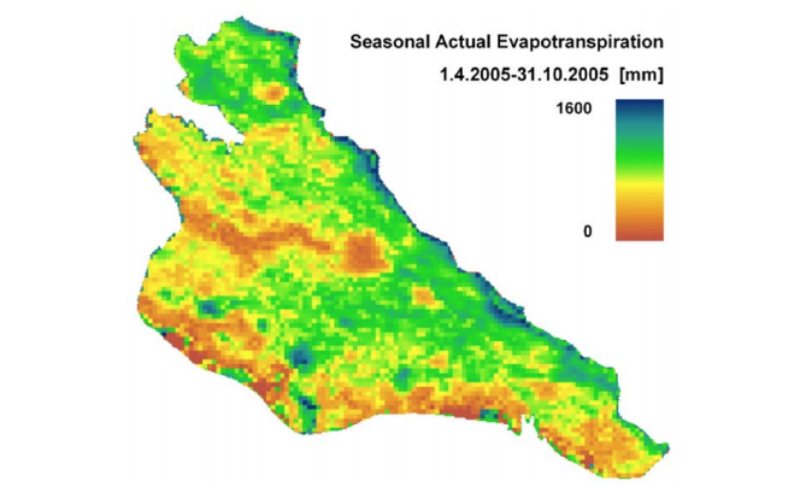
At the level of main canal system, a spatially-explicit irrigation water distribution model was developed to optimise irrigation water distribution and enhance water productivity in the entire canal system covering 22,850 ha of irrigated land. This model is currently being applied and evaluated by the local irrigation managers.
Modifying the state order system for cotton
While the state procurement mechanism for cotton will not be abolished in the near future, there are options to render this system easier and make it more attractive to the producers. For instance, a more flexible state procurement mechanism can be introduced, which sets the cotton production targets for individual farmers rather than area quotas. Even a multiyear production plan can be introduced with fixed amount of cotton production targeted over more years rather than one single year. These modifications of the state procurement system will provide incentives to farmers to increase cotton production per unit area (i.e. fulfilling cotton quotas on smaller area), which will enable them to allocate more of their land to crops with higher profits. In such a modified state order system, farmers will be able to make their own decisions on adoption of those innovative technologies that not only enhance crop production but also help improving soil fertility, such as diversification of crop portfolio, introduction of new crop rotations, and implementation of soil and water conservation practices (Djanibekov et al. forthcoming).
Increasing local processing of cotton fibre
As the state-ordered cotton production is the major consumer of water in the region, any reduction in the area of this crop will undoubtedly result in using water saving. Given that only 10% of total cotton production is processed locally in Khorezm, one economically viable option to reduce cotton area is the development of textile industry and export of value-added products. Findings of a detailed study on the cotton value chain indicated that increasing cotton fibre processing into yarn by only 10% would allow achieving the same regional export revenue while reducing the area sown to cotton by 30000 ha, saving 228 million m³ of water, and removing about 6 million USD in explicit subsidies (Rudenko 2008). Thus, developing a strong cotton textile industry is one of the key factors for improving the economic viability, rural employment, water productivity, and ecological sustainability of the Khorezm region.
Integrating rice irrigation into water planning
To be able to keep track of water in the irrigation system and make decision-making on rice irrigation water more transparent, we suggest that rice on fermer land, which is freed from the state order, should be included in the formal water allocations and in the water fees of the WUAs as a separate position. The same applies to an earlier decision-making on the cropping of rice as a second crop after wheat.
Water user association (WUA) level
Due to insufficient human and financial resources and lack of water users’ participation in decisionmaking processes regarding water distribution, the WUAs in the region are generally unable to establish flexible, on-demand, and equitable irrigation scheduling systems. In addition, there is insufficient coordination and communication of irrigation activities among the water users, WUA members, and higher-hierarchy state water management institutions. These structural deficiencies together with infrastructural deficits, such as missing or non-appropriate diversion and measurement structures, lead to substantial water losses. Results of our two-year study in an irrigation sub-unit (850 ha) revealed that on average 16.5 Mio m³ water (2700 mm) was diverted to this area. About 4.2 Mio m³ (700 mm) was used in pre-season leaching of salts. The remaining water (2000 mm) is more than double the amount recommended for the irrigation of cotton. Our estimations of technical irrigation efficiency of approx. 30% and a field application efficiency of 45% reflect that a high share of these water quantities do not reach the crops. These findings are in line with our estimations of irrigation water losses at the regional level based on remote sensing. Our research on social mobilisation in one case study WUA has shown that even if water users are granted the possibility and space to get involved, they are very hesitant to do so. The common governance structures people are used to are top-down with centralised command and control mechanisms. WUAs rely on good relations with state representatives to represent water users upwards and lobby for water. In return, interference into WUA-activities at the WMO-level, by district and regional governors can be observed regularly.
Governance of water in a participatory way does not come natural to fermers, dehqons or the local elites (Hornidge et al. 2009). Experience and knowledge on how to conduct elections and meetings or how to ensure transparency are often not available. Instead of using the WUA as platform to show agency, farmers rely on their patron-and-client networks as described above. This leads to a side-stepping of the WUA and further weakens its possibilities to function adequately.
The problems at WUA level have led to a situation in which neither the water users, nor the WUA staff, nor the state water management staff were satisfied with the resulting water management. During the water scarce year of 2008, dissatisfaction of all involved led to incessant complaints to the WMOs. This in turn may have been the reason for consolidating farm land in 2008, which resulted in significant reduction in the number of water users, and thereby easing water management at WUA level, although the total area to be irrigated did not change. The following options can help improving the performance of WUAs.
Raising funds: Development of WUAs as business units
Even the currently low water and membership fees will not be paid without a reform of the incentive structures for water users to cover the costs of the WUA. As shown above, the principal functions of WUAs include water distribution, cost-recovery, governance and representation. However, a WUA may work as a business unit and have a range of ancillary functions such as the provision of management services, training, extension, and insurance or short term credit to individuals or rural communities or farmers. Such additional functions will decrease the marginal cost of the production and will motivate farmers to pay for water. Once fees are regularly paid, the WUA can provide more additional functions for societal benefits using the resources raised. If the users perceive benefits generated from such functions, they will be further motivated to pay the fees. The WUA and its members should follow the principal of reciprocal accountability, i.e. if a water user does not pay for services he does not receive water, and, in turn, the WUA is not paid if it fails to provide the required services.
Increasing participation: Empowerment and social mobilisation
A joint experiment of researchers, fermers and WUA staff in WUA Ashirmat has shown that social mobilisation implemented by well-known and accepted people can increase awareness among water users of the WUA’s existence and work (Hornidge et al. 2009). However, this is only the first step towards higher participation in the WUA’s activities. To create room for water users to communicate their needs and represent their interests, it is necessary for the WUA to conduct regular meetings, so that water users’ needs are acknowledged and ownership of the WUA is developed. Stratification among the water users which is related to geographical location should be reduced by introducing canal managers for different parts of canals, so that e.g. tail-enders have representation mechanisms to secure their water access. Dehqons should also be included in the information and decision-making processes.
Improving the technical performance: Water measurement devices and irrigation scheduling models
One of the critical factors for transparent, equitable, and timely distribution of water to individual farmers’ fields is the availability of water measurement and monitoring devices, such as gauging rods (water-depth rods), flow-meters on pumping stations, and flow-measuring flumes and weirs at all offtakes into fields of fermers and dehqons. These devices at the WUA level are generally out-dated and imprecise or non-existent. Establishing the appropriate water measurement system on all water sources and entering the information in a common database accessible to WUA members and water users are the pre-requisites for improving the efficiency and productivity of irrigation management system.Once the necessary water monitoring infrastructure is in place, irrigation scheduling models can be used to optimise water distribution to crop fields. By accounting for short-term variations in weather conditions, these models allow a flexible and on-demand irrigation scheduling during the crop season, which results in enhanced water productivity. Detailed modelling studies in the project suggest that matching the timing of irrigation events to actual crop water demand, instead of the presently widely-practiced norm-based irrigation scheduling, can save 25% of water without incurring any yield penalty.
Farmer and field level
The water management problems discussed for the WUA level make adequate water delivery (timing and quantity) highly uncertain. This unreliability of supply is reflected in practices of tail-end fermers who tend to over-irrigate once water is available or block drains and collectors to raise the groundwater level, so that groundwater can contribute to crop water requirements. While this makes sense in the fermers’ situation to cope with uncertainty of water supply in the short-term perspective, it also has long-term negative impacts, such as secondary soil salinisation, which is a widespread phenomenon in the region.In addition, irrigation scheduling in Khorezm is based on norms which were developed in the 1960s. Since then, soil characteristics and groundwater levels have changed, farm size and the number of farmers/water users have altered, cropping patterns have diversified, and new modelling tools to calculate season-specific crop water requirements and estimate irrigation efficiencies have been developed. Consequently, these norms, while remaining helpful tools for estimating large-scale total crop water requirements, fail to provide flexible and on-demand irrigation scheduling, which is required for improving water productivity of cropping systems. Furthermore, awareness on water-saving and adoption rate of water-efficient irrigation technologies are generally low. Inefficient use and wastage of water can be attributed to a range of factors including lack of land tenure security, area- and production-based state quota on cotton and wheat, highly subsidised water supply, unreliable water delivery, lack of economic incentives, and technical deficiencies in irrigation and drainage infrastructure. To improve the efficiency of water use at farm and field level, we suggest here some technical options that should go alongside changes in the institutional setting that create awareness on water-saving as well as space for innovation.
Optimizing the water application process
Due to the flat topography, double-sided irrigation is a highly suitable application method in Khorezm. Results of field experiments suggest that, compared to the conventional furrow irrigation technique, double-sided irrigation technique can save 15% water. Furthermore, the increase in salt accumulation at the end of the furrows due to low irrigation water application and high capillary rise could be halved, and as a consequence cotton yield increased by 0.5 t ha-1 (Paluasheva 2005). Improvement in operation and design of the furrow technique (optimizing application discharge; introducing surge flow; laser land levelling) allows to raise the application efficiency from currently 45% to 65%.
Adequate irrigation scheduling
As an alternative to the widespread use of outdated irrigation norms, scheduling of irrigation events based on simulation models of crop-soil-water dynamics can help better matching of water supply to crop demand. Our simulation studies revealed that a flexible and on-demand irrigation scheduling, instead of the norm-based approach, provides a water saving potential of 20% without causing reduction in crop yields. The excessive volumes of water applied for pre-season salt leaching (700 mm) can also be significantly reduced by site-specific methods that account for actual soil salinity in the crop root zone. Combining modern soil salinity monitoring devices, such as the electromagnetic induction device EM-38, and models of soil salinity dynamics (for instance the HYDRUS model) can reduce the leaching water use significantly (Akramkhanov et al. 2008; Forkutsa et al. 2009).
Water pricing
The question of whether introducing water pricing may impact water conservation in Khorezm was examined using a modelling approach (Bobojonov 2008). The simulation results indicated that a direct pricing for irrigation water indeed bears the potential for increasing water use efficiency of about 5-6 % and for increasing the financial resources of the water management organizations. However, to recover the costs of the entire system, prices would need to be as high as 9 USD per thousand m³ for irrigation water. However, introducing a price for water only makes this mechanism unattractive under the present state procurement system. Various findings (Bobojonov 2008, Rudenko and Lamers 2006) recurrently warn for an over-optimism and estimated a reduced impact when introducing isolated measures. Thus, water pricing would yield much more effects when flanked by other measures such as an easing of the state procurement system and allowing crop diversification.
Strengthening water inspection
In 2009, WUA Ashirmat introduced local water inspectors (Ul Hassan et al. 2010) – a promising innovation which should be followed by other WUAs too. Local water inspectors should cooperate with the district inspectors of Uzsuvnazorat and make use of its formal sanctioning mechanisms. It can be expected that the local inspectors will feel more bound to their fellow villagers than to the state organisation Uzsuvnazorat and would try to avoid a control function with sanctioning mechanism. However, the mere existence of water inspection on local level and social sanctioning mechanisms would have a strong impact on water-saving awareness on the local level.
Build capacity and promote water-saving
In addition to these control mechanisms, Uzsuvnazorat together with local water inspectors should widen their functions and adopt a more prominent role in the education of water users on water wastage and water-saving. Concrete water-saving measures are currently only promoted through the annual Pakaz meetings of fermers in which state representatives communicate agricultural norms and regulations, which occasionally also relate to water-saving (i.e. shorter furrows). Awarenessraising campaigns as well as capacity building during and in addition to the state trainings should be conducted more systematically and frequently. By continuously being alerted about water-saving and by acquiring the skills and techniques to practice it, water users would be able to develop ownership of water-saving instead of considering water management and water-saving ‘up to the state’ only
Abdullaev, I., Kazbekov, J., Manthritilake, H., Jumaboev, K., 2009: Participatory water management at the main canal: a case from South Ferghana Canal in Uzbekistan. Journal of Agricultural Water Management 96(2): 317-329.
Abdullaev. I, Nurmetova. F, Abdullaeva. F, Lamers., J.P.A., 2008: Socio- technical aspects of water management in Uzbekistan: Emerging water governance issues at the grass root level. In: Rahaman, M.M. and O. Varis (eds.): Central Asian Water. Water & Development Publications – Helsinki University of Technology, Helsinki, Finland, 89-103.
Akramkhanov, R., Sommer, A., Martius, C., Hendrickx, J.M.H., Vlek, P.L.G., 2008: Comparison and sensitivity of measurement techniques for spatial distribution of soil salinity. Irrigation and Drainage Systems, 22: 115-126.
Bobojonov, I., 2008: Modeling Crop and Water Allocation under Uncertainty in Irrigated Agriculture. A Case Study on the Khorezm Region, Uzbekistan. PhD thesis.University of Bonn, Germany.
Conrad, C., 2007: Estimation of water productivity in irrigated river basins using remote sensing and geoinformation techniques: a case study in Khorezm river basin, Uzbekistan. PhD thesis, University of Würzburg, Germany.
Conrad, C., Dech, S.W., Hafeez, M., Lamers, J.P.A, Tischbein, B., (submitted): Remote sensing and hydrological measurement based irrigation performance assessments in the upper Amu Darya Delta, Central Asia. Physics and Chemistry of the Earth.
Djanibekov, N., 2008: A Microeconomics Analysis of Farm Restructuring in the Khorezm Region, Uzbekistan. PhD thesis.University of Bonn, Germany.
Djanibekov, N., Bobojonov I., Lamers, J.P.A., 2010: Land consolidation for increasing cotton production, but sufficient for triggering rural development in Uzbekistan? In IAMO Studies on the Agricultural and Food Sector in Central and Eastern Europe (eds): Kelly Labar, Martin Petrick and Gertrud Buchenrieder (In press).
Djanibekov, N., Rudenko, I., Lamers, J.P.A, Bobojonov, I., forthcoming: State-Ordered Cotton Production in Uzbekistan, Central Asia: Two Sides of the ‘White Gold’ Medal. Case prepared for Cornell University.
Forkutsa, I., R. Sommer, R., Shirokova, Y., Lamers, J.P.A., Kienzler, K., Tischbein, B., Martius, C., Vlek, P.L.G., 2009: Modeling irrigated cotton with shallow groundwater in the Aral Sea Basin of Uzbekistan: II. Soil salinity dynamics. Irrigation Science 27(4): 319-330.
Glantz, M. H., 2008: Sustainable development and creeping environmental problems in the Aral Sea region. In M. H. Glantz (Ed): Creeping Environmental problems and Sustainable Development in the Aral Sea Basin. Cambridge University Press, pp 1-25.
Hornidge, A.-K., M. Ul Hassan, et al., 2009: ‘Follow the Innovation’ – A joint experimentation and learning approach to transdisciplinary innovation research. ZEF Working Paper Series No. 39.
Martius, C., Froebrich, J., Nuppenau, E.-A., 2009: Water resource management for improving environmental security and rural livelihoods in the irrigated Amu Darya Lowlands. In: Brauch, H.G., Oswald Spring, Ú., Grin, J., Mesjasz, C., KameriMbote, P., Chadha Behera, N., Chourou, B., Krummenacher, H. (eds.): Facing global environmental change: environmental, human, energy, food, health and water security concepts 4. Berlin/Heidelberg /New York: Springer, 749-762. Micklin, P., 2007: The Aral Sea Disaster. Annu. Rev. Earth Planet. Sci., 35: 47-72 Müller, M., 2006: A general equilibrium approach to modeling water and land use reforms in Uzbekistan. PhD thesis. Center for Development Research (ZEF), University of Bonn.
Oberkircher, L., Tischbein B., Hornidge, A.-K., Schorcht, G., Bhaduri, A., Awan, U. K., Manschadi, A. M., 2010: Reconceptualising Water Management in Khorezm, Uzbekistan / Recommendations towards IWRM, ZEF Working Paper Series. Vol. 54. Bonn: Zentrum für Entwicklungsforschung.
Oberkircher, L. and B. Ismailova, forthcoming: On Pumps and Paradigms: Water Scarcity and Technology Adoption in Uzbekistan. Society & Natural Resources, Scholar One.
Paluasheva, G., 2005: Dynamics of soil saline regime depending on irrigation technology in conditions of Khorezm oasis. In: Proceedings of the International Scientific Conference: ‘Scientific Support as a Factor for Sustainable Development of Water Managment’: Taraz, Khazakhstan, 20-22 October 2005 (in Russian) Rudenko, I., 2008: Value chains for rural and regional development: The case of cotton, wheat, fruit, and vegetable value chains in the lower reaches of the Amu Darya River, Uzbekistan. PhD thesis. Center for Development Research (ZEF), University of Bonn.
Ul Hassan, M. et al., 2010: Improving the Performance of the Ashirmat Water Users Association through Social Mobilization and Institutional Development. ZEF/UNESCO Khorezm project’s internal documentation. Work package 720: Follow the Innovation.
Veldwisch, G.J., 2008: Cotton, Rice & Water: Transformation of Agrarian Relations, Irrigation Technology and Water Distribution in Khorezm, Uzbekistan. PhD thesis. University of Bonn, Germany
Zusammenfassung
„Weißes Gold“ und Aralsee-Syndrom: Ansätze für eine effizientere Wassernutzung in der Provinz Khorezm, Usbekistan
Die Bewässerungswirtschaft in der am Unterlauf des Amu Darya gelegenen usbekischen Provinz Khorezm weist eine Reihe von Defiziten auf, die nicht nur für viele Be- und Entwässerungssysteme im Aralsee-Einzugsgebiet typisch sind, sondern die auch in der Summe in den vergangenen Jahrzehnten zu dem Aralsee-Dilemma geführt haben. Ineffiziente Wassernutzung, unzureichende Erfüllung der Anforderungen der Wassernutzer und gravierende Belastungen der Boden- und Wasserressourcen kennzeichnen die Situation in Khorezm. Die erwarteten Auswirkungen der Klimaänderung und eine zukünftig verstärkte Nutzung der Wasserressourcen im oberen Teil des Amu Darya-Einzugsgebiets begründen die Befürchtung, dass die in Khorezm verfügbaren Wasserressourcen zukünftig knapper werden und stärkeren Schwankungen ausgesetzt sein werden. Damit steht die Bewässerungswirtschaft in Khorezm (und im gesamten Einzugsgebiet des Aralsees) vor der Herausforderung, die Wasser- und Landnutzung auf ökonomische Effizienz, ökologische Nachhaltigkeit und soziale Verträglichkeit umzustrukturieren.
Da die Ursachen für die bestehenden Defizite in einem Mix aus technischen, institutionellen und sozio-ökonomischen Ursachen liegen, kann der Umstrukturierungsprozess nur dann dauerhaft erfolgreich sein, wenn entsprechende, Ursachen-orientierte Ansätze auf allen relevanten Ebenen der Wasser- und Landnutzung kombiniert werden. Auf der Grundlage intensiver und mit lokalen Partnern durchgeführten Felduntersuchungen sowie Modellierungen wurden im Rahmen des vom BMBF finanziell geförderten ZEF/UNESCO-Projektes institutionelle, ökonomische und technische Komponenten erarbeitet und als Umstrukturierungskonzepte für die Ebene der Region, der Wassernutzer-gemeinschaften (WUAs) und der Wassernutzer entwickelt. Fernerkundungs- und GISgestützte Verfahren zur Landnutzungsklassifikation und zur Bestimmung der aktuellen Evapotranspiration liefern wertvolle Daten für die regionale Wasserbilanzierung, die Beurteilung der Bewässerungsdurchführung, die Bewässerungsplanung sowie deren operationeller Verbesserung.
Ein Modell zur Optimierung der Wasserverteilung für den Versorgungsbereich eines Hauptkanals wird derzeit mit lokalen Wassermanagern in der Praxis getestet. Die Berücksichtigung des Reisanbaus in der Wasserverteilungsplanung lässt eine verbesserte Annäherung der bisherigen offiziellen Wasserverteilung an die Realität erwarten. Die Umsetzung von Wasserverteilungsplänen kann dadurch gesteigert werden, dass die Repräsentanten der Wassernutzergemeinschaften stärker in die Planung der regionalen Wasserallokation eingebunden werden. Eine schrittweise Flexibilisierung der zentralen Planung des Baumwollanbaus ist geeignet, die Eigenverantwortung der Landwirte zu stärken und auf diesem Wege ein Produktions- und Innovationspotenzial zu mobilisieren. Durch Modellsimulationen wurde nachgewiesen, dass ein Ausbau der Baumwollverarbeitung sowohl die Wertschöpfung verbessert als auch die Boden- und Wasserressourcen schont. Auf der Ebene der WUAs gilt es, die Partizipation der Wassernutzer durch Maßnahmen der sozialen Mobilisation zu verbessern und die ServiceFunktionen um genossenschaftliche Elemente zu erweitern, um auf diesem Wege die Akzeptanz der WUAs in der Bevölkerung zu steigern. Die Anwendung flexibler Bewässerungssteuerungsmodelle erlaubt eine bessere Erfüllung des räumlich-zeitlich variablen Bedarfs. Um die Implementierung daraus resultierender Wasserverteilungspläne zur ermöglichen, ist eine Rehabilitierung der hydraulischen Bauwerke insbesondere im Hinblick auf die Mess- und Dosiereinrichtungen notwendig. Die im Projekt auf der Feldebene entwickelten Modelle erlauben es, situations-spezifische Bewässerungskennwerte zu ermitteln. In Verbindung mit Ansätzen für eine verbesserte Wasseraufleitung wird der Landwirt in die Lage versetzt, das Bewässerungswasser effizienter und produktiver zu nutzen. Die Einführung von Verbrauchs-abhängigen Wassergebühren, die Stärkung bestehender Kontrollinstanzen und die intensivierte Vermittlung von Techniken der Wassereinsparung stellen geeignete Maßnahmen dar, das vorhandene Potenzial für einen effizienten Umgang mit der Ressource Wasser stärker als bisher zu nutzen.





